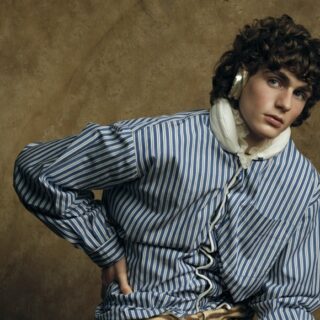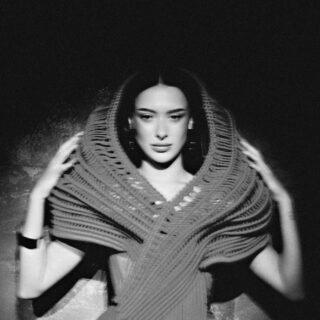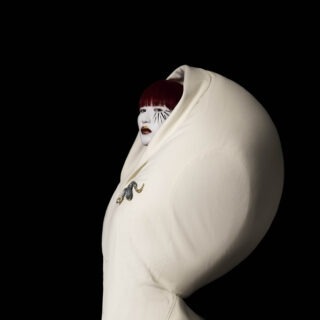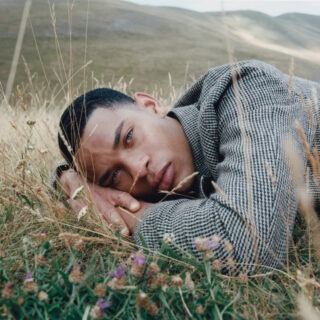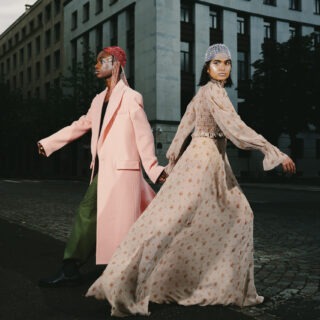words. Odyssia Houstis
If you were to briefly explain your work and its purpose to a diverse group of people with different ages and backgrounds, how would you describe it in simple terms?
I am an artist, and my purpose is to bring sublime, healing experiences to the world through a multidisciplinary approach. This has been my mission since 2012. And I’ve been doing that all this time. This clear and focused mission acts as my North Star, guiding my journey.
What insights from your childhood have molded you into the influential, mindful artist and speaker you are today?
I wasn’t always the person I am today; I was a very shy girl growing up. I grew up with two younger sisters and my father is my mentor. He is a retired acupuncturist and martial arts grandmaster, who was one of the first pioneering martial artists in North America from South Korea. Our upbringing revolved around holistic wellness. My father was a high-performance Martial Arts athlete, who taught us a holistic lifestyle of natural medicine, meditation, discipline, and self-defense. We were exposed to spirituality, discipline, and the importance of service and education. However, my journey wasn’t always smooth sailing. I went through a difficult divorce and meditation and art saved me, allowing me to rebuild my identity, and self-worth, and ultimately, find the courage to pursue my passion for art. My practice of transcendental meditation, which began in 2013 while living in Singapore, played a significant role in my transformation.
What inspires you to create these mesmerizing pieces of art?
My love for architecture and design has always been strong, and my time living in Japan between 2005 and 2008 was transformative. It was in Kyoto that I experienced the power of Zen through art, which led me to appreciate the impact of Zen consciousness on my creative process. Although I didn’t have a regular meditation practice until 2013, I realized back then that the ancient monks who designed beautiful spaces like the Ryon-ji Temple Garden were brilliant artists, and their work served humanity by creating immersive experiences that induce a state of Zen.
Your Techism manifesto in 2014 and your Digital Consciousness series are groundbreaking works. Did your meditative practice, which began in 2013, open up new creative doors for you?
Yes, practicing transcendental meditation (TM) has been a gift, unlocking my personal creativity. I felt an urgency to write the Techism manifesto, as there was a glaring lack of dialogue about the disruptive impact of technology on our culture during my time at LaSalle College of the Arts. I wanted to bridge the gap between art, science, and technology by encouraging collaboration and holistic thinking. Artists should aim to make a real-world impact and contribute to the cultural dialogue. That’s the true purpose of art.
What inspires you to create these mesmerizing pieces of art?
My love for architecture and design has always been strong, and my time living in Japan between 2005 and 2008 was transformative. It was in Kyoto that I experienced the power of Zen through art, which led me to appreciate the impact of Zen consciousness on my creative process. Although I didn’t have a regular meditation practice until 2013, I realized back then that the ancient monks who designed beautiful spaces like the Ryon-ji Temple Garden were brilliant artists, and their work served humanity by creating immersive experiences that induce a state of Zen. Your Techism manifesto in 2014 and your Digital Consciousness series are groundbreaking works. Did your meditative practice, which began in 2013, open up new creative doors for you? Yes, practicing transcendental meditation (TM) has been a gift, unlocking my personal creativity. I felt an urgency to write the Techism manifesto, as there was a glaring lack of dialogue about the disruptive impact of technology on our culture during my time at Lasalle College of the Arts. I wanted to bridge the gap between art, science, and technology by encouraging collaboration and holistic thinking. Artists should aim to make a real-world impact and contribute to the cultural dialogue. That’s the true purpose of art. In the current landscape, many people don’t understand Web3, the metaverse, or the potential of these technologies. As someone with an optimistic vision of the metaverse, artificial intelligence, and blockchain, how do you address people’s fears and misconceptions? The most effective way to address these fears is by providing solutions to the problems using technology. I primarily focus on mental health and sustainability, as these are universal concerns. Web3 and blockchain technologies allow us to authenticate real versus fake information and manage systems of commerce and exchange transparently. When combined with AI, we can instantly verify information and have AI agents protect our data, helping us gain stability and security in a chaotic world.Blockchain can create a foundational layer for our digital identities, authenticated by unique biometric data such as our heartbeats. This can be linked to our avatars in The Metaverse, enabling accurate healthcare readings and personalized wellness recommendations. AI and blockchain technologies can improve our lives, making us smarter, healthier, and better human beings. By establishing a secure digital identity, we can prevent identity theft, deep fakes, and other potential misuse of power technology.
What potential dangers or opportunities do you see in adopting Web3 technologies?
By authenticating individuals through the blockchain using their unique heartbeat, we can create a permanent, immutable form of identification. For instance, as a writer, your work would have your NFT signature connected to your heartbeat, ensuring that your creations are genuine and traceable. This technology will be vital in helping people to differentiate between authentic and fake content. As a result, I believe that the adoption of Web3 technologies will serve as a defense against the risks associated with AIinsurgency.
How significant is the role of women in this emerging space?
The viability of the metaverse is contingent upon the active participation of women. I believe it is essential to seek out women’s collectives and support networks in the global Web3 space. The emergence of these groups is increasingly evident, with more and more of them dedicated to onboarding women. It is crucial to recognize the transformative potential of Web3 in leveling the playing field for women, and providing unparalleled opportunities for equality, diversity, and access. Web3 holds the promise ofenabling women to make a profound and lasting impact, making it undeniably a world suited to them. In order to foster a balanced and flourishing metaverse, women’sinvolvement is crucial.
How do you perceive the current divide between the visions of those deeply involved in these emerging technologies and the rest of the population?
Indeed, there exists a knowledge gap surrounding Web3, as evidenced by the lack of understanding even at TED events. The majority of people remain unaware of the benefits and applications of NFTs and blockchain technology. Older generations, entrenched in the Web2 system, struggle to grasp these concepts, while young generations, such as Gen Z and Gen Alpha, are poised for widespread adoption. As such, education is crucial to bridge this divide and facilitate the integration of these technologies into society.
What steps should parents take to educate their children about these technological advancements and their potential impact on society?
As for the resources for children, it is true that we are still in the early stages and must be candid about our present limitations. Despite my current tunnel vision, I am keenly aware of the need to educate the masses. One of the projects I am currently working on revolves around mental health. I aspire to connect children worldwide to safe, AI-curated spaces through the simple click of a button on their devices. These spaces will be supervised by AI-powered adults, providing children in need with immediate mental health support, rather than waiting months for an appointment with an overbooked professional. There is a stark shortage of therapists globally, especially for children, and it is our responsibility to address this pressing concern.
What is the role of mental health and higher consciousness in the metaverse among industry leaders?
I am grateful for the support I receive as I champion the metaverse as a solution to the mental health crisis. Collaborating with visionary Deepak Chopra, we are developing an AI avatar that merges technology and spirituality. He is really at the forefront of technology and spirituality. He’s a real guru. I’m also going to be speaking at Davos in January about this very topic and giving a presentation on how we can actually make concrete programming in the metaverse that benefits everyone that’s accessible because we have the technology. We’re capable of doing it now. So, what I’m doing is very unique in the space. Everyone else during the hype phase of the metaverse, was concerned with selling plots of land but my position was that you need to sell experiences. This unique approach in the creator’s economy aims to enrich lives and draw people into the metaverse meaningfully. That’s the only way you’re going to bring people into the metaverse with education, health and wellness, and culture.
How do you envision the future of the metaverse?
I believe that the future of the metaverse will center around a creator’s economy built on blockchain technology. Currently, closed metaverse platforms limit interoperability, but the development of an open metaverse, such as Lamina1, will enable the seamless transfer of assets and experiences across different realms. By focusing on providing valuable experiences for education, health, and wellness, we can attract more people to the metaverse and create a more inclusive metaverse.
How do you plan to reach more people with your message and your art?
Utilizing media to discuss my work, giving speeches, and educating the masses is essential to spreading my message. I am also exploring different ways to make a larger impact, and being in LA presents various opportunities. Though I have collaborated with major brands like Lanvin and Louis Vuitton, I believe having my own platform is crucial to communicating my message. I’m currently working on a book and considering a documentary series.
Can you share any examples of virtual reality being used to reduce stress, and are there any collaborations or projects that are currently addressing mental health in the metaverse?
There is an app developed called Reulay by a great team in collaboration with Dr. SriniPillay, a renowned Harvard psychiatrist and neuroscientist. He is at the forefront of creating VR installations to mitigate stress, and the app is currently being used by NBA teams and war veterans. Dr. Pillay and I are working together on developing effective,science-backed mental health programming in the metaverse. We recently presented our work on how the metaverse can help alleviate mental health issues at the annual Metaverse conferences in Monaco, called MEW Metaverse Entertainment WorldSummit.
words. Odyssia Houstis
photos. courtesy of Krista Kim
© Schön! Switzerland. All rights reserved.

